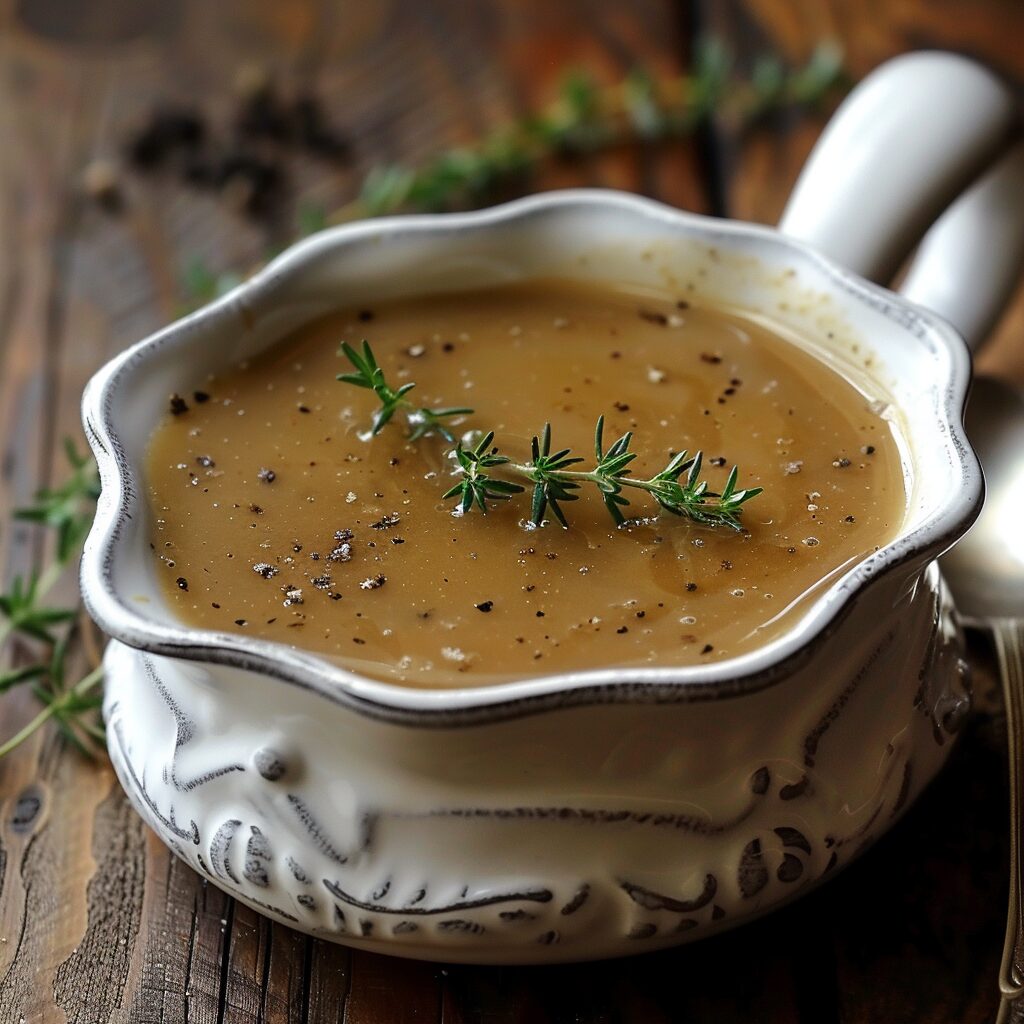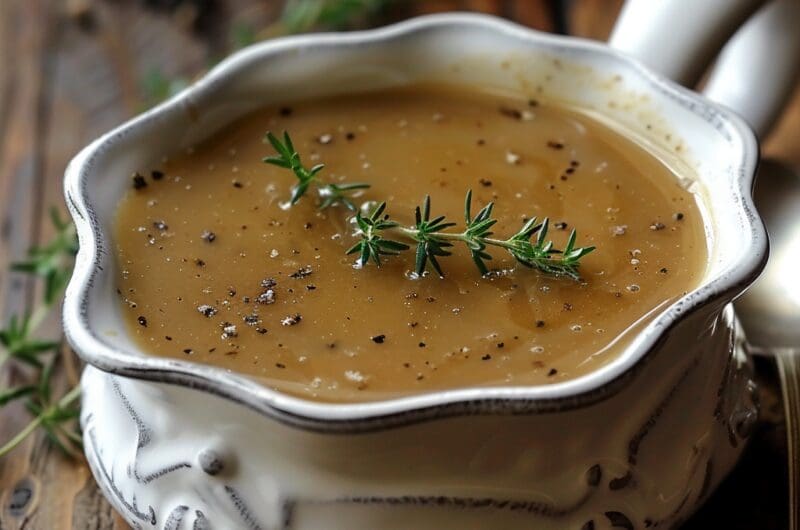Imagine sitting down to a meal where the gravy is so divine, it becomes the star of the show. That’s the kind of experience I’m here to help you create. Whether it’s drizzled over mashed potatoes, used to enhance the flavor of a roast, or simply enjoyed with biscuits, the right gravy can transform a good meal into a great one. This article will guide you through creating a memorable gravy recipe that’s not only easy to make but also irresistibly delicious.
The Secret to Silky-Smooth Gravy
Every great gravy starts with a foundation known as a roux, a simple mix of fat and flour cooked together until golden. The roux’s magic lies in its thickening power, providing your gravy with the perfect silky-smooth texture. For an unforgettable gravy, use butter for its rich flavor, complemented by flour to achieve the ideal consistency.
But the real secret ingredient? Patience. Letting the roux reach a light golden brown without rushing ensures your gravy will have a deep, nuanced flavor without any raw flour taste.
Once your roux is ready, slowly incorporate your liquid of choice. Whether it’s the drippings from your roast for that unbeatable umami flavor or a high-quality broth, the key is to add it gradually while whisking continuously to prevent lumps.
Tip: For an extra flavor boost, consider adding a splash of wine or Worcestershire sauce as you whisk in your liquid.
Customizing Your Gravy
Your gravy should be a reflection of the meal it complements. Adding herbs, spices, or even a dash of soy sauce can elevate your gravy to new heights. Consider the profile of your dish and select additions that will harmonize with the main flavors.
For a richer experience, some chefs swear by finishing their gravy with a touch of cream or a knob of butter, stirred in just before serving. This last-minute addition adds a luxurious texture and rounds out the flavors beautifully.
If you’re aiming for a gravy that stands out, don’t shy away from experimenting with ingredients like lemon juice for a bit of acidity or even a pinch of sugar to balance the flavors. Remember, the best recipes are often born from a little bit of creativity and a lot of love.
Tip: Always taste your gravy as you go. Adjusting the seasoning gradually ensures you hit just the right note.
Overcoming Common Gravy Challenges
Encountering lumps? A fine mesh strainer can be your best friend. Simply strain your gravy to achieve that perfect smooth texture. If your gravy’s too thin, a slurry of cornstarch and water can thicken it up. On the flip side, if it’s too thick, a little extra broth can loosen it to your desired consistency.
Another common hurdle is achieving the perfect balance of flavors. If you find your gravy too salty, a small amount of sugar or a splash of cream can soften the saltiness. For gravies lacking in depth, a pinch of umami-rich ingredients like mushroom powder or soy sauce can provide a much-needed flavor boost.
And remember, the color of your gravy can add to the visual appeal of your dish. If you’re looking for a darker hue, a little bit of soy sauce or kitchen bouquet can deepen the color without altering the flavor too much.
Tip: Don’t forget the power of presentation. Serve your gravy in a pre-warmed gravy boat to keep it at the perfect temperature throughout your meal.
In the end, making an unforgettable gravy comes down to a balance of technique, patience, and personal taste. With a bit of practice and experimentation, you’ll find your signature gravy recipe that will have your guests asking for seconds, and maybe even thirds.
So, the next time you’re in the kitchen, remember that the perfect gravy isn’t just about the right ingredients; it’s about bringing those ingredients together in a way that complements your main dish and elevates your entire meal. With this guide, you’re well on your way to creating a gravy that’s not just good, but memorable.
Unforgettable Gravy Recipe
Course: Main CourseCuisine: American4
servings30
minutes40
minutes300
kcalMaster the art of making silky, flavorful gravy with this easy-to-follow guide, perfect for any meal.
Ingredients
4 tbsp butter
4 tbsp all-purpose flour
2 cups broth (chicken or beef)
Salt and pepper to taste
Optional: herbs, wine, Worcestershire sauce for flavor
Directions
- Melt the butter in a large skillet over medium heat until it’s bubbling. Avoid letting the butter brown or burn, as this can affect the taste of your gravy.
- Whisk in the flour gradually to avoid lumps. Cook the mixture, stirring constantly, until it turns a light golden brown. This roux will thicken your gravy and add a rich flavor.
- Gradually add the broth, whisking continuously to ensure the mixture stays smooth. Bring to a gentle boil; the gravy will start to thicken.
- Reduce heat and simmer for 10-15 minutes, stirring occasionally. If you’re adding optional ingredients like herbs or wine, do so now. Adjust seasoning with salt and pepper to taste.
Notes
- For a thinner gravy, add more broth until you reach your desired consistency.
- If the gravy is too thick, continue to cook on a lower heat and add additional liquid as needed.
- Gravy can be made ahead and reheated, adding a little broth to thin if necessary.
Frequently Asked Questions
Q: Can I make this gravy gluten-free?
A: Yes, to make this gravy gluten-free, substitute the all-purpose flour with a gluten-free flour blend that’s designed to work as a 1:1 replacement. Keep in mind that the consistency may vary slightly, so adjust the liquid as needed.
Q: How can I prevent my gravy from getting lumpy?
A: The key to preventing lumps is to whisk the flour into the butter thoroughly before gradually adding the broth. If lumps do form, you can strain the gravy through a fine mesh sieve or blend it with an immersion blender until smooth.
Q: Can I freeze leftover gravy?
A: Yes, you can freeze gravy, but it’s best to do so before adding any cream or milk, as dairy-based gravies can separate when thawed. Freeze in an airtight container and gently reheat, adding a little broth if necessary to adjust consistency.
Q: What can I do if my gravy is too thin?
A: If your gravy is too thin, let it simmer a bit longer to reduce and thicken. Alternatively, you can mix a small amount of flour with broth to create a slurry and whisk it into the gravy, then simmer for a few minutes to thicken.


